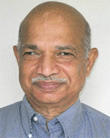full article:
Dear Editor
The elimination of avoidable blindness in remote, rural areas where primary healthcare facilities are rudimentary, is very complex. We report on efforts to tackle this challenge using members of local community (Vision Health Guardians, VHGs) in a small remote village in India (population 746 in Adilabad District) to integrate community eye care with primary health care.
The important components of this initiative were:
- identification and training of VHG volunteers
- awareness building about eye care among the villagers
- providing quality eye care services
- linking primary eye care with primary health care and referral services
- community development initiatives such as improvement in environmental sanitation
- training village youth in vocational skills to enable income supplementation.
Vision health guardians
Screening
Primary eye care outcomes: Of the 746 participants studied, a total of 200 participants (26.8%) were already using eye glasses at the time of survey for reported eye problems. In total, 97.5% (n=727) underwent comprehensive eye examination. Thirteen individuals (1.7%) were found to be blind (visual acuity in better eye <6/60) due to cataracts. The following avoidable causes of blindness were found: cataract in 31 (4.2%), refractive error in 43 (5.9%). Seven subjects underwent cataract surgery and 17 subjects with significant refractive errors were prescribed glasses.
Community general health screening: A community general health screening program was organized to identify common health problems in the village. These screening programs were meant to enhance health-seeking behavior and to provide scope for an interaction between the community and health-service providers.
Community development initiatives
The VHG Development Initiatives included the following:
- Village vision committee formation: A village vision committee was constituted first with village leaders and six members of the youth club, of whom two volunteered to be VHGs. The village vision committee supported the activities of VHGs.
- Livelihood support: Vocational training was imparted in the form of domestic electrical wiring and maintenance of electrical pump sets, to 25 vision health guardians.
- Nutritional Intervention: The concept 'vision garden' was introduced to the villagers. Saplings were supplied and vision gardens were raised. These gardens have common perennial plants with an edible product rich in vitamin A (eg sweet potato tubers, papaya fruits, drumstick leaves, curry leaves). These gardens are easy to maintain, require minimum care and the concept is propagated by word of mouth.
Conclusion
This initiative that integrated primary eye care with primary health care using VHGs was well received by this rural community in India. As such it is a promising concept. Considering the high prevalence of blindness and visual impairment in the rural population this approach is worthy of consideration as a simple, affordable, sustainable, and replicable model.
Suresh Kuruganti MPH, Jayanthi Mekala MSW, Jachin Williams MSW,
Sannapaneni Krishnaiah MPhil, Gullapalli N Rao MD,
Padmaja Kumari Rani FNB(Retina),
International Centre for Advancement of Rural Eye Care (ICARE)
L V Prasad Eye Institute, Hyderabad, India





